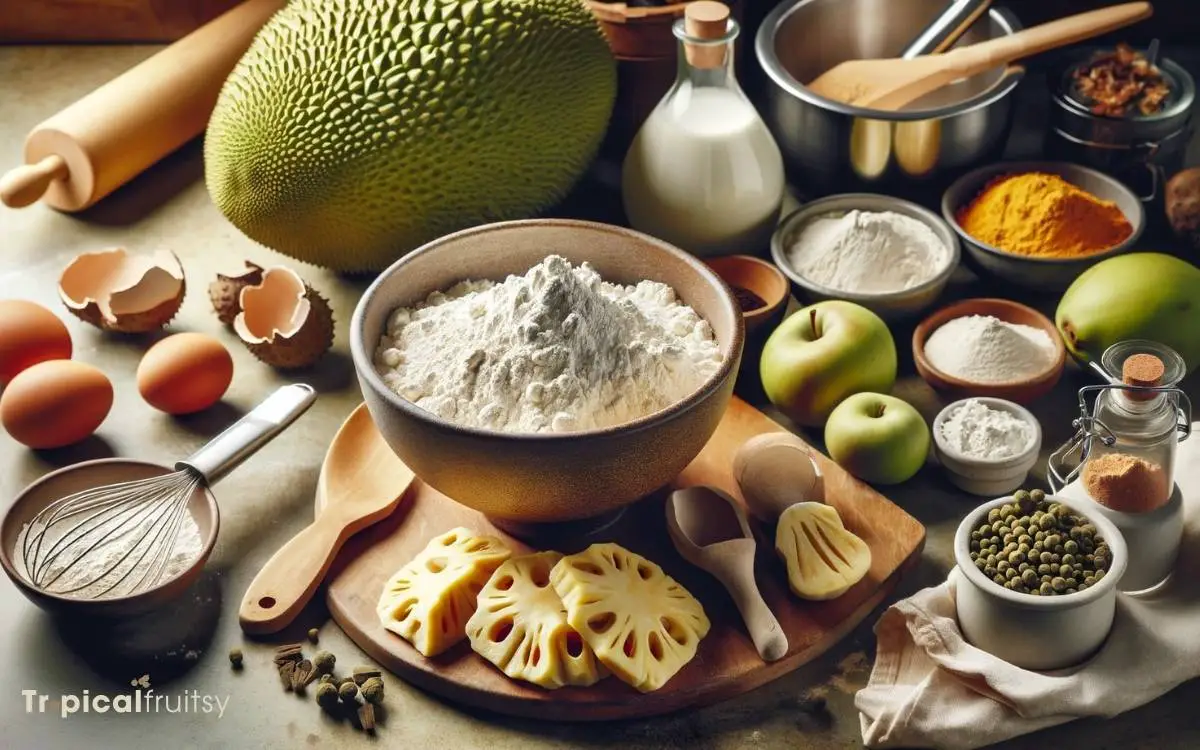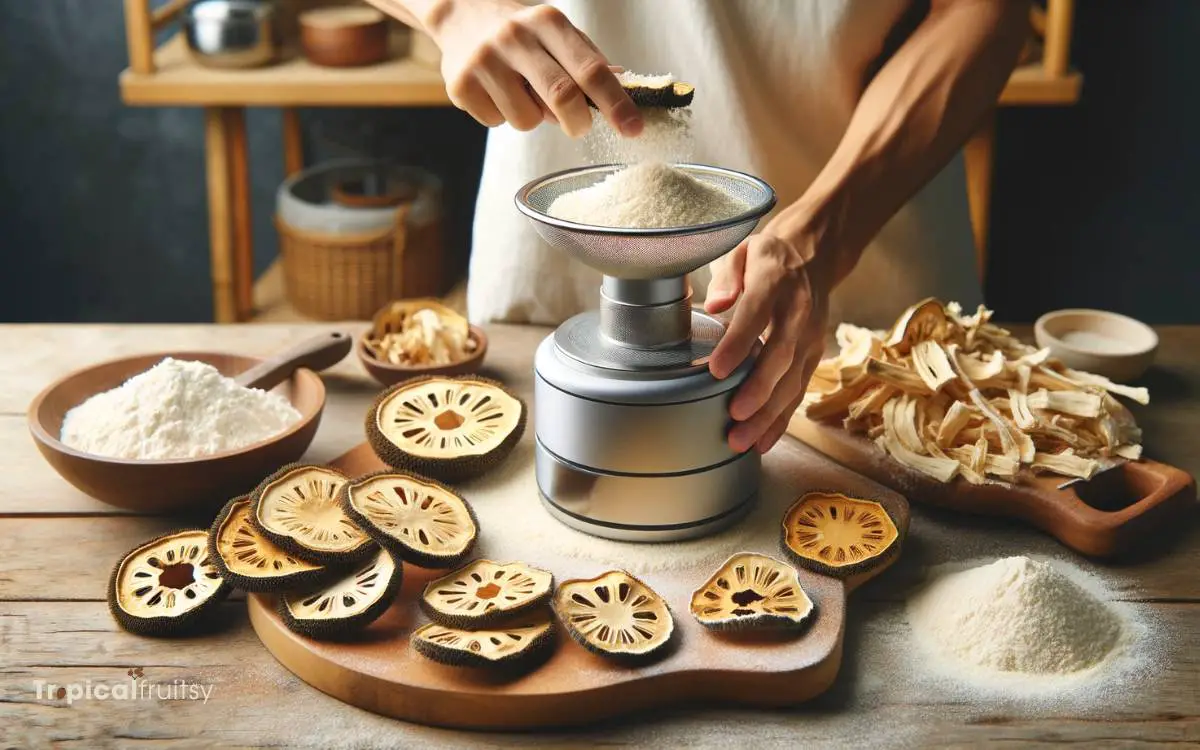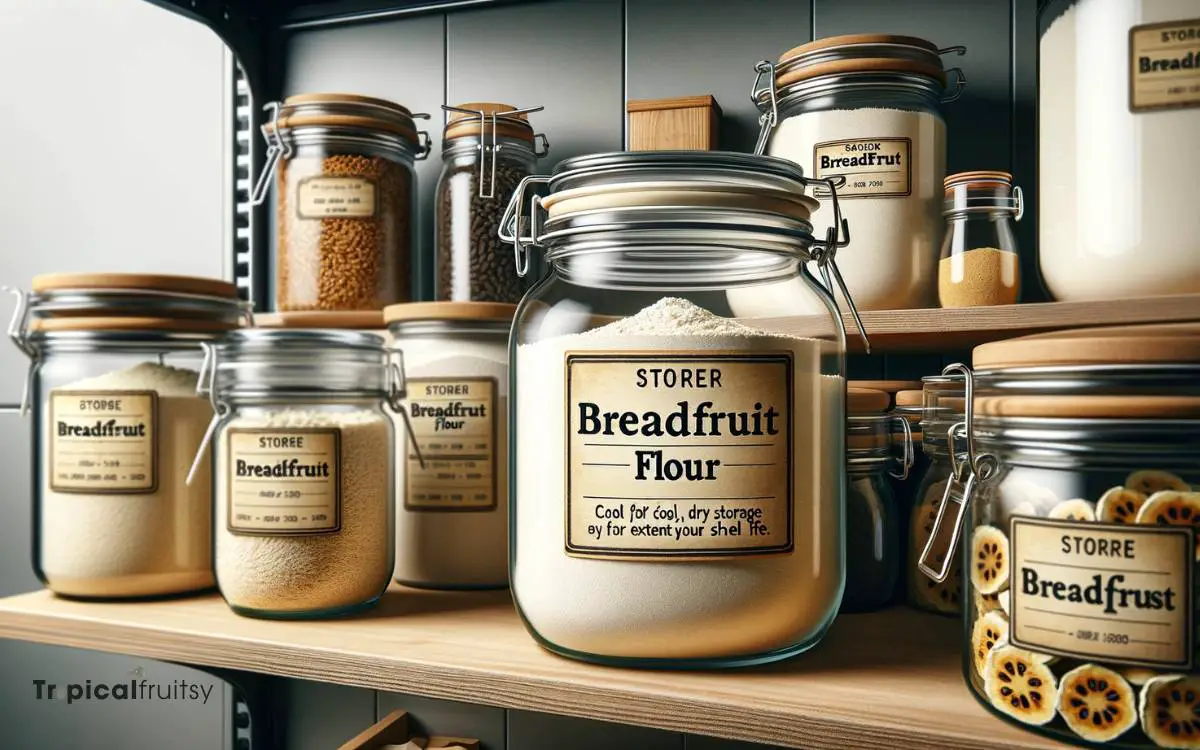How to Use Breadfruit Flour? 4 Easy Steps!
Breadfruit flour is a nutritious, gluten-free flour alternative derived from the breadfruit tree’s fruit. It’s suitable for various culinary applications and is particularly popular among those with gluten sensitivities or seeking healthier flour options.
To make breadfruit flour at home, dehydrate ripe breadfruit flesh and grind it into powder. Store it in an airtight container in a cool, dry place.
It can replace wheat flour in recipes at a 1:1 ratio but may require adjustments for optimal results, especially in baking.
Breadfruit flour is made from the dried and ground flesh of ripe breadfruit.
Here are some quick steps:
For example, when baking bread, you may need to combine breadfruit flour with other flours or binding agents to achieve the desired texture.
Incorporate breadfruit flour into your diet to enjoy a gluten-free and sustainable alternative full of flavor and nutrition.

Key Takeaway
Step 1: Selecting Quality Breadfruit

To ensure the finest quality of breadfruit flour, one must first zero in on selecting premium, mature breadfruit with no signs of spoilage or damage.
The procurement process demands a discerning eye, as the maturity of the fruit directly influences the starch content—critical for the flour’s final texture and performance.
One should conduct a meticulous examination for uniformity in color and feel, seeking out a firmness indicative of peak ripeness.
Additionally, understanding the subtle nuances of the breadfruit’s surface can reveal its internal quality.
With the selection of optimal breadfruit completed, the focus shifts to the meticulous process of making your own flour.
Step 2: Making Your Own Flour

Several steps are involved in transforming select breadfruit into a fine, versatile flour suitable for various culinary applications.
Initially, the harvested breadfruit must be meticulously cleansed to eradicate superficial impurities.
This is followed by an intricate process of peeling, coring, and slicing, which prepares the fruit for dehydration—a critical phase where moisture content is strategically reduced to enhance preservation and facilitate milling.
Utilizing a dehydrator or an alternative low-heat drying method ensures consistent texture and quality.
The desiccated slices are then pulverized into a powdery consistency using a high-performance mill or grinder.
The resulting flour must be sifted to achieve uniform fineness, thereby optimizing it for an array of gastronomic creations.
Precision at every juncture is paramount to yield a product that is both functional and nutritionally robust.
Step 3: Storing Breadfruit Flour

Once you have successfully milled your breadfruit into flour, proper storage is essential to maintain its freshness and extend its shelf life. The biochemical stability of breadfruit flour is contingent upon a meticulous storage protocol.
You should store the flour in an airtight container, shielded from moisture and odorous substances, to prevent the absorption of extraneous scents and humidity, which can precipitate spoilage.
Positioning the container in a cool, dark environment will further inhibit the degradation of vital nutrients and the proliferation of spoilage organisms.
For prolonged storage, refrigeration or even freezing can be considered. This will retard rancidity and enzymatic activity, two primary concerns that can compromise the integrity of breadfruit flour over time.
Step 4: Substituting Traditional Flours

You can easily substitute breadfruit flour for traditional wheat flour in many recipes to offer a gluten-free alternative with a nutritional boost.
When integrating breadfruit flour into your cooking and baking, consider the following:
- Breadfruit flour can be used at a 1:1 ratio in most recipes, but you may need to adjust the liquid content due to its higher absorption rate.
- Its mild flavor makes it suitable for both savory and sweet dishes, enhancing versatility without overpowering other ingredients.
- For optimal texture in baked goods, mix breadfruit flour with other gluten-free flours to achieve the desired consistency.
When substituting, it’s crucial to analyze the role of wheat flour within your recipe and adjust the breadfruit flour quantity and complementary ingredients accordingly to maintain structure and flavor integrity.
Can I Use Breadfruit Flour to Make Breadfruit Cake?
Yes, breadfruit flour can be used to make breadfruit cake. To find out how to make breadfruit cake, consider following a recipe that specifically uses breadfruit flour. These recipes typically involve combining breadfruit flour with other ingredients such as sugar, eggs, and butter, and baking it until it reaches a cake-like consistency. Enjoy experimenting with this unique and flavorful cake variation.
Cooking and Baking Tips
One must carefully consider the unique properties of breadfruit flour when adapting recipes for cooking and baking to ensure successful results. This innovative ingredient exhibits a distinct composition, requiring precision in its application.
Breadfruit flour is gluten-free, affecting the structure and texture of baked goods. To counterbalance this, one might integrate binding agents such as xanthan gum or eggs.
Its absorbency also differs from that of wheat flour; thus, adjustments in liquid proportions are pivotal to maintain moisture levels.
Analytically speaking, breadfruit flour imparts a subtle flavor, making it suitable for both savory and sweet dishes.
When used in baking, it’s advisable to start by replacing only a portion of wheat flour to evaluate its effect on the final product, gradually increasing the quantity as desired for taste and consistency.
Conclusion
The utilization of breadfruit flour presents a sustainable and nutritious alternative to conventional grain flours.
Its adoption could significantly contribute to food security, considering that a single breadfruit tree can yield up to 200 fruits per season, potentially providing a substantial source of food material.
The integration of breadfruit flour into culinary practices not only promotes dietary diversity but also supports agricultural innovation and environmental sustainability.






